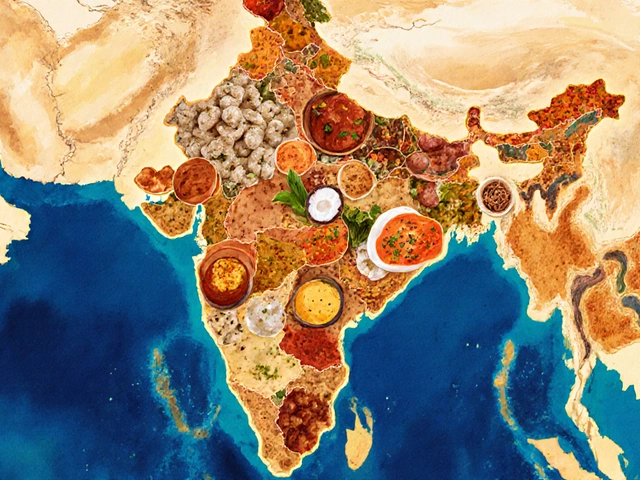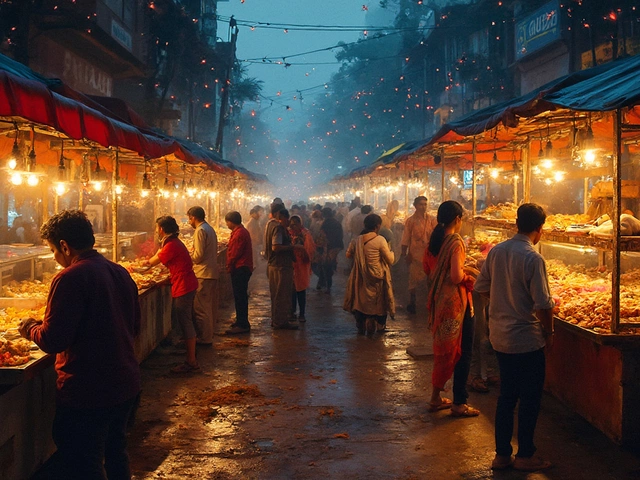Global Vegetarian Population Calculator
More than 400 million people in the world don’t eat meat. That’s more than the entire population of the United States. And the vast majority of them live in one country: India. If you’ve ever eaten a plate of dal chawal, a spicy samosa, or a creamy paneer tikka masala, you’ve tasted the legacy of a culture where vegetarianism isn’t just a choice-it’s woven into daily life, religion, and tradition.
Why India Leads the World in Vegetarianism
India has the highest number of vegetarians on Earth. Estimates from the Pew Research Center and the Indian National Family Health Survey put the number between 38% and 40% of the population-roughly 400 to 450 million people. That’s more vegetarians than the entire population of the European Union. And it’s not because they’re following a trend or a fitness app. It’s because for centuries, religious beliefs, social norms, and agricultural realities have made plant-based eating the default.
In Hinduism, the largest religion in India, the principle of ahimsa-non-violence toward all living beings-shapes food choices. Many Hindus avoid meat because they believe all life is sacred. Jains take this even further, avoiding root vegetables like onions and potatoes because harvesting them kills the plant. Buddhists in India, especially in regions like Ladakh and Sikkim, also follow vegetarian diets as part of their spiritual practice.
It’s not just about religion. For millions of rural families, meat is simply too expensive. Lentils, rice, millet, and vegetables are affordable, filling, and grown locally. A bowl of khichdi-rice and lentils cooked with turmeric and cumin-is a staple across villages from Punjab to Tamil Nadu. It’s nutritious, easy to make, and lasts for days. In many homes, meat is reserved for special occasions, if it’s eaten at all.
What Do Indian Vegetarians Actually Eat?
When people think of Indian vegetarian food, they often picture bland tofu and overcooked vegetables. That couldn’t be further from the truth. Indian vegetarian cuisine is one of the most diverse and flavorful in the world. It’s built on layers of spices, fermentation, and technique.
Take chana masala: chickpeas simmered in a tangy tomato sauce with cumin, coriander, amchoor (dry mango powder), and black salt. Or baingan bharta: roasted eggplant mashed with garlic, chili, and mustard oil. Even simple dishes like dal tadka-lentils tempered with cumin and dried red chilies-have deep, complex flavors.
India’s regional diversity means vegetarian food varies wildly. In Gujarat, meals are sweet-savory, with jaggery in dals and chutneys. In Maharashtra, people eat pav bhaji-a spicy vegetable mash served with buttered bread. In South India, fermented rice and lentil batters turn into crispy dosas and fluffy idlis, served with coconut chutney and sambar. And in the north, paneer-a fresh, non-melting cheese-shows up in curries, grilled skewers, and even desserts like paneer kheer.
There’s also a thriving street food culture built entirely on plants. Think aloo tikki (spiced potato patties), papdi chaat (crispy wafers with yogurt and tamarind), and sev puri (fried dough topped with chickpeas and spices). These aren’t side dishes-they’re full meals.

How It Compares to the Rest of the World
Other countries have vegetarian populations, but none come close to India’s scale or depth.
Israel has the highest percentage of vegetarians outside India-around 13% of its population, mostly in cities like Tel Aviv. But that’s still less than 1 million people. The United States has about 5% vegetarians-roughly 16 million. The UK and Germany each have 2-3%. Even in countries with strong plant-based movements like Sweden or Canada, vegetarianism is often a lifestyle choice, not a cultural norm.
What sets India apart is how deeply vegetarianism is embedded. It’s not something you ‘go vegan for’-it’s something you grow up with. You don’t need to explain why you don’t eat meat. Your grandmother already knows. Your school lunch doesn’t include chicken. Your wedding feast has 20 vegetarian dishes and zero meat.
And it’s not just about avoiding meat. Many Indian vegetarians also avoid eggs, making their diet closer to veganism than the typical Western vegetarian diet. In fact, the term “vegetarian” in India often includes egg-free eating. That’s why Indian restaurants abroad often have separate menus for “veg” and “vegan”-because they’re not the same thing there.
Myths About Indian Vegetarianism
There are a few misconceptions that keep people from understanding Indian vegetarian food.
Myth 1: Indian vegetarian food is boring. False. The spice blends alone-garam masala, panch phoron, sambar powder-are complex enough to make any chef jealous. The textures range from creamy (dal) to crunchy (papadum) to chewy (paneer). The flavors are sweet, sour, spicy, and earthy-all in one bite.
Myth 2: Vegetarians in India don’t get enough protein. Wrong. Lentils, chickpeas, soy, paneer, yogurt, and nuts are protein powerhouses. A typical Indian vegetarian meal includes at least two protein sources. A plate of dal, rice, and curd gives you complete amino acids. No supplements needed.
Myth 3: It’s only for religious people. Not true. While religion drives much of the practice, economic and environmental reasons play a huge role. Many urban Indians, even non-religious ones, choose vegetarianism because it’s cheaper, healthier, and better for the planet. A 2023 study by the Indian Institute of Public Health found that vegetarian households spent 30% less on food than meat-eating ones.

Why This Matters Beyond the Plate
India’s vegetarian culture has global implications. It’s the reason plant-based food companies are investing heavily in India. It’s why global brands like Beyond Meat and Impossible Foods are partnering with Indian chains to create localized versions of their products. It’s why the world’s largest vegetarian food festival-VegFest India-draws over 100,000 people every year.
It also challenges the idea that vegetarianism is a Western trend. For most of human history, plant-based eating was the norm in Asia, Africa, and parts of the Middle East. Western diets, with their heavy reliance on meat and dairy, are the outlier. India reminds us that a world without meat isn’t a sacrifice-it’s a rich, ancient, and delicious way of life.
What You Can Learn From Indian Vegetarianism
If you’re curious about eating more plants, India offers real-world lessons:
- Start with lentils. They’re cheap, cook fast, and pack protein. Try masoor dal or chana dal.
- Use spices boldly. Cumin, turmeric, coriander, and mustard seeds transform simple ingredients.
- Don’t fear fermentation. Idli and dosa batter are naturally probiotic and easy to make.
- Build meals around grains and legumes. Rice + dal = complete protein. No meat required.
- Explore regional dishes. One country, 28 states, hundreds of vegetarian traditions.
You don’t need to become fully vegetarian to benefit. Even adding one plant-based meal a week-like a bowl of chana masala with roti-can make a difference. And if you do go all in? You’re joining a tradition older than most modern nations.
Is India the only country with a large vegetarian population?
No, but it’s by far the largest. Israel, Nepal, and Ethiopia have significant vegetarian populations, but none come close to India’s 400+ million. Other countries have higher percentages of vegetarians relative to population size, like Israel (13%) or Taiwan (12%), but India’s sheer numbers make it the global leader.
Do all Indians eat vegetarian food?
No. Around 60% of Indians eat meat or fish regularly, especially in coastal regions like Kerala, Bengal, and the Northeast. But even in meat-eating households, vegetarian meals are common-often eaten daily, with meat reserved for weekends or celebrations.
Are Indian vegetarians vegan?
Many are, but not all. In India, “vegetarian” usually means no meat or fish, but eggs are often included. However, strict vegetarians-especially Jains and many Hindus-avoid eggs, honey, and sometimes even root vegetables. So while not all Indian vegetarians are vegan, a large portion follow diets closer to veganism than Western vegetarians do.
What’s the most popular vegetarian dish in India?
There’s no single answer-it depends on the region. But dal tadka (lentils with tempered spices) and chana masala (spiced chickpeas) are eaten daily across the country. In the south, idli with sambar is the morning staple. In the north, paneer butter masala and aloo gobi are household favorites. Street food like pav bhaji and aloo tikki are also top choices.
Why don’t more people outside India become vegetarian?
It’s not just about food-it’s about culture. In many Western countries, meat is tied to ideas of prosperity, masculinity, and tradition. In India, vegetarianism is normalized from childhood. There’s no stigma, no social pressure to eat meat. Without that cultural foundation, changing diets is harder. But as awareness grows about health and climate, more people are looking to Indian cuisine as a model.











